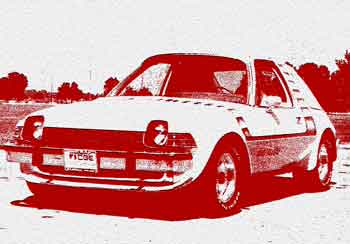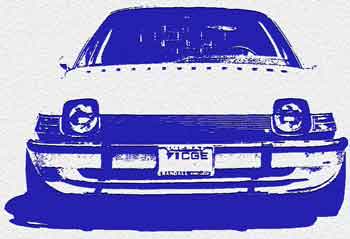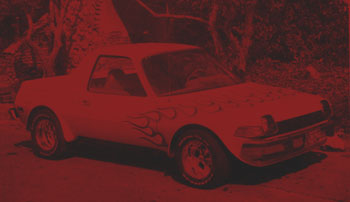 |
ABOUT THE SITE | CONTACT |
| History & Stats |
| Classifieds |
| Technical Info |
| Famous Pacers |
| Pacer Stories |
| Photos & Images |
| Collectibles |
| Multimedia |
| Resources |
Who is Carl Green?
by Beth Troy
Who is Carl Green?
A tinkerer who converted his childhood hobby of transforming the old cars of the Kansas countryside into an itinerant career of customizing cars for hot rodders. He is the namesake of the CGE Pacer, he is the designer of the uniquely esoteric Pacer pickup and his life’s goal is the same as that of the World’s Fastest Indian.
“I like to go fast,” he said.
Shoot, I don’t know the difference between a master cylinder and six cylinder, but I still want to be Carl Green when I grow up.
So, how did Green grow up?
“Well, growing up in the country in central Kansas there wasn’t a whole lot to do but take cars apart and put them back together,” Green explained. “I cut up a lot of cars that never got put back together.”
At 13, Green found his first success with a 1928, Ford Model A coupe.
“It was a joint effort with my brother, who was 15,” Green said. “We cut the top off to make it a convertible and used a brush to paint it red and white. We painted lightening bolts on the doors and put a number 11 on it because 1’s were the easiest number to paint.”
 In the mid-1960s, Green moved to Topeka to work in a speed shop that transformed
standard engines into high-performance engines. Soon thereafter, Darryl Starbird,
a custom-car and hot-rod designer, hosted a car show in which Green really,
really, really wanted to serve as a “flunky.”
In the mid-1960s, Green moved to Topeka to work in a speed shop that transformed
standard engines into high-performance engines. Soon thereafter, Darryl Starbird,
a custom-car and hot-rod designer, hosted a car show in which Green really,
really, really wanted to serve as a “flunky.”“By the end of the weekend, I had bothered him enough, and he told me I could come to Wichita to work for him part-time,” Green said.
Thus began Green’s career of regular moves and irregular work hours. To gain professional experience on engines, Green moonlighted at The Boeing Company from 4:30 p.m. to 1 a.m. after putting in an eight-hour workday with Starbird. He would then return to Starbird’s shop to practice welding for a couple of hours.
When did he sleep?
“I didn’t very much, but I was only 20, had inexhaustible energy and was excited about the opportunity,” Green said.
Green stopped working on aircraft engines after six months, but continued to intermittently work for Starbird during the next five years. During this time, his developing expertise in hammer welding also led him to California to work for Dean Jeffries, the automotive styler of the Monkey Mobile, and to work in Chicago for Dave Puhl at the House Kustoms. The latter was a one-year project called the Phaz II, which incidentally involved an AMC 343 engine.
For the next few years, Green continued his gypsy travels around the country to develop custom cars for movies, movie stars and automotive magazines, but he received no credit because he modified the cars under the names of other designers.
“Each person I worked under had their own style, and I took the best from each one of them and applied it to my processes,” Green said. “Most of these guys wouldn’t let their competition see anything, but because I worked for them, I got on the inside track.”
In 1974, Green took the leap and set up Carl Green Enterprises in Van Nuys, California with the help of his friend, Gene Winfield. Movie and magazine-feature cars accounted for much of his business, but he also began in earnest his work on Pacers.
 “Where I lived was a hub for custom-built cars, but I was pretty much the only
AMC guy there. I was pretty much the only AMC guy period,” Green said, and then
laughed. “You know, I always picked the underdogs.”
“Where I lived was a hub for custom-built cars, but I was pretty much the only
AMC guy there. I was pretty much the only AMC guy period,” Green said, and then
laughed. “You know, I always picked the underdogs.”But, a spot of pity wasn’t Green’s only rationale to sweat over Pacer customization.
“It was a challenge because it’s the only car I ever worked on that wasn’t the same from left to right,” Green said. “The passenger’s door is four inches longer than the driver’s door, which makes everything on the passenger’s side slightly different. I couldn’t duplicate anything.”
Green partnered with Randall AMC in Mesa, AZ to do a custom-car design of the Pacer in two issues of Hot Rod magazine (see below). The dealer installed an AMC 401 engine, but the larger engine required larger tires “so that the V-8 didn’t burn the skinny wheels of the Pacer,” Green explained.
Green built flares for the wheel wells, designed a front spoiler and did a custom-paint job. He bought the car from Randall AMC and showcased it at the AMC car show in Las Vegas.
“The dealers were all excited about this performance car,” Carl said. “The Pacer was kind of bland, and there wasn’t anything that gave it a kick. In magazine articles, they called it the Poor Man’s Porsche. The Pacer handled well, but it looked like a Porsche that had been squeezed the wrong way.”
The positive feedback birthed the CGE Pacer. Green made fiberglass molds of his customization and advertised the kits to AMC dealers as a way to morph the Pacer into a more muscular vehicle with a better stance.
“I got the list of dealers from AMC and made up a brochure for the body kit,” Green said. “I still remember buying the stamps because I couldn’t believe how much they cost. I realized that I would have to sell at least three kits to pay for just the stamps.”
Green recouped his stamp expenditure and then some. He sold around 150 kits to AMC dealers from New Jersey to Canada, Texas and California.
The resulting press of the CGE Pacer sparked a friendship between Green and Dick Teague, the designer of the Pacer and Vice President of Design at AMC. Teague back-doored Pacers, Gremlins and Jeeps for Green to modify for magazine features.
 Green shared with Teague his idea of a Pacer pickup, and, in 1976, Green used
the platform of a preproduction Pacer station wagon to create his brainchild.
Throughout the four-month project, Green was careful to maintain the body style
without flare, fender or spoiler modifications. He even went so far as to paint
the pickup burnt orange, a stock AMC color. He sent photos of the pickup to
Teague.
Green shared with Teague his idea of a Pacer pickup, and, in 1976, Green used
the platform of a preproduction Pacer station wagon to create his brainchild.
Throughout the four-month project, Green was careful to maintain the body style
without flare, fender or spoiler modifications. He even went so far as to paint
the pickup burnt orange, a stock AMC color. He sent photos of the pickup to
Teague.Teague's response?
“‘Where are the flares?’ he asked me,” Green said. “He wanted a sport truck, so I added flares, larger tires, and flames.”
Pacer urban legend has it that several Pacer pickups existed due to the 36 magazine articles published on the pickup.
“I started repainting it so that it looked like a different pickup,” Green said to reveal his slight of hand. “There are a lot of people out there that think there were a half dozen pickups, but it was the same one.”
Though AMC took the pickup on tour in 1977 to raise capital from banks and investment companies, the company struggled to remain afloat. The demise of AMC did not, however, stop Green’s work with the Pacer. He painted the returned pickup red, white, and blue, dubbed it the “Lil’ Gopher” and gave it to Evel Knievel as a utility vehicle for his shows. He also customized Pacers to serve as BF Goodrich pace cars for the IMSA racing circuit, and Amos Johnson and Howdy Holmes raced CGE Pacers in the circuit as team HiBall.
I had to ask: How did the CGE stand up to the racecar competition?
“Well, I think they did okay,” Green said.
Green’s Pacer days eventually set, but the gap quickly filled with one-off custom designs and magazine features for Fords, Toyotas, Cadillacs, and other makes. He reconstructed the famed Rod and Custom Dream Truck of the early 1950s and built an all-metal bat mobile. Currently, he is a guest of the television show, Building With the Best, produced by Rich Evans and his old friend Winfield, in which he and the rest of the best restore Bill Cushenbery’s legendary Silhouette of the early 1960s. And then of course, he tinkers with his own cars: a Ford Focus, a Honda Element, and very soon, a Mini Cooper S.
“I have to modify them. I cannot drive a car that is not modified. It’s against my religion,” he joked.
In 2000, Green’s Pacer pickup made its way to the National Rod & Custom Car Hall of Fame Museum that his mentor, Starbird, founded. Green had donated the pickup in the late 1970s to a friend who installed four-wheel drive on the pickup. So, as fate would have it, Green’s history with Pacers is not yet finished.
“The four-wheel drive just ruined the looks of it, so what I am going to do is take the undercarriage out from under it and put the original carriage under it,” said Green, ever the tinkerer. “I still have one more appointment with the Pacer pickup.”
And should another Pacer owner, perhaps yourself, wish to send your trusty stead to Green for a modification?
“I would change the design of the flares that I did for the CGE because I never did really like the shape of them,” Green began. “And, I would change the front spoiler. And, I would put rectangular headlights in the grill and flatten the hood,” he said and paused. “And, I would take a foot out of the top. It was so much top.”
Beth Troy is a freelance writer and owner of Wordsmith Documentation, LLC, a documentation consulting company.
Copyright © 2007 Wordsmith Documentation, LLC.
Links
- Carl Green Design on ShoutLife.com: Includes more pictures of Carl's Pacers and other projects through the years.
- NEW! Cushenbery Project YouTube channel
Articles
CGE Pacer
- "Project: Racer Pacer", Hot Rod, 2/1976
Pages 40-41, 42
- "Project Pacer: CGE is the Pacer's Edge", Hot Rod, 3/1976
Pages 54-55, 56, 121
Pacer Pickup
- "The Great Green Hope", Pickup, Van & 4WD, 7/1977
Cover, page 68
"The 'Great Green Hope ' article was written by Eric Dahlquist, publisher at the time of Argus Publications. He was so upset with American Motors (as you can tell from reading the article), that he wrote the story and put it right in the middle of the AMC section of the Argus 1978 New Cars book. As you were reading the reviews on AMC cars, when you turned the page, there was the 'Great Green Hope' story. It was really an embarrassment to AMC, which was what Eric wanted to do. It was a total surprise to me, as I new nothing about the article being written. Argus was doing stories on me in Popular Hot Rodding, 1001 Custom & Rod Ideas, and he took pics and info from those stories." -Carl Green
- "How to Donate Your Historic Vehicle to the National Rod & Custom Car
Hall of Fame for Fun & Profit", Street Rodder, 4/2002
Pages 250-251
This article features Don Ashworth's donation of the Pacer Pickup to the Hall of Fame.
- Trombino's Car
coverage of the Pacer pickup in the Starbird Museum
- Coming soon! Trucking Trends, 1977
Other CGE Projects & Press
- "FOW Shop Tour: U.S. Concepts", Fun on Wheels, 10/1994
Page 50, 51
Fun on Wheels toured Carl Green's Arkansas-based U.S. Concepts shop. The article contains a great collection of photographs of his various projects, including the Pacer pickup.
- "RAMBO: Blown Ram V10 Sport Utility", Today's Truck, 12/1995
Cover
"The 'RAMBO' is the prototype SUV I built in 1994 on a Dodge pick up platform. It won the Chrysler 'Excellence in Design' award at the SEMA Show in Las Vegas in 1994." -Carl Green
- "Darryl Starbird Opens New Hall of Fame Museum Wing!", Custom Rodder,
11/1999
Page 34, 35
This article showcases (and pictures) the Cushenbery "Mystery Car", which Green is currently restoring in California.
- Dodge Ram Limousine
- NEW!
"Cushenbery's Silhouette II Mystery Car is Back", Autobody News,
3/2/2008
NEW! "Blowing Plexiglass Bubble Top For Long-Lost Mystery Hot Rod", Autobody News, 3/2/2008
ABOUT THE SITE | CONTACT
© 1995-2025 panhorst.net, L.L.C.